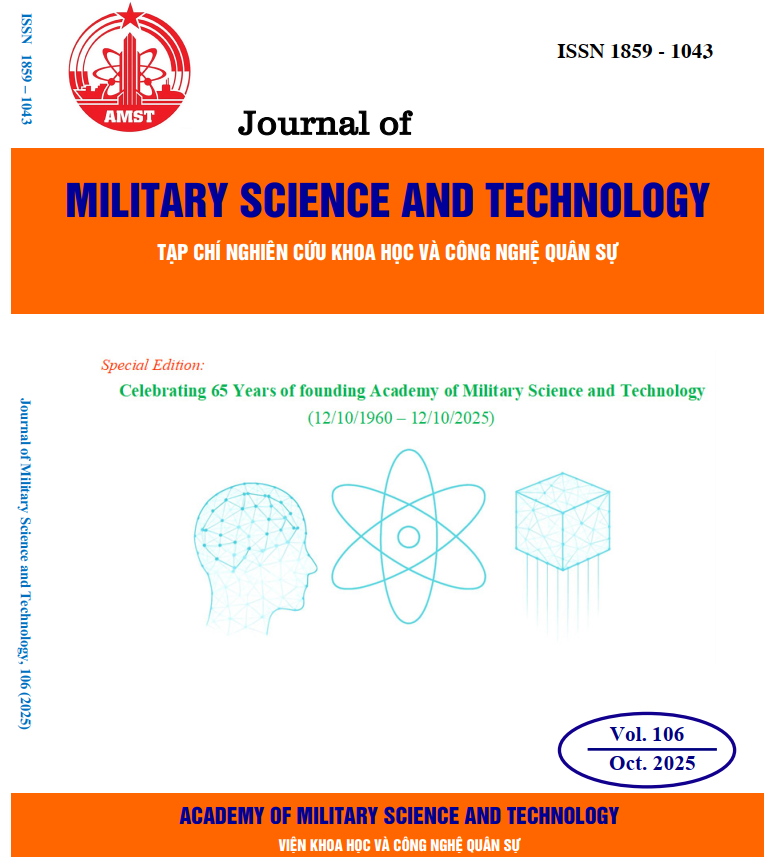Nghiên cứu khả năng xử lý trinitrotoluene trong nước bằng phương pháp quang oxi hóa UV/WO3/H2O2
DOI:
https://doi.org/10.54939/1859-1043.j.mst.106.2025.94-101Từ khóa:
Vonfram trioxit; Quang oxy hóa; Trinitrotoluen; Xử lý.Tóm tắt
Bài báo trình bày kết quả tổng hợp vật liệu WO₃ bằng phương pháp kết tủa hóa học, cùng với việc đánh giá các tính chất hóa–lý, hình thái, cấu trúc tinh thể và đặc điểm hóa học của vật liệu. Ngoài ra, các kết quả sơ bộ cũng được giới thiệu về hiệu suất xử lý TNT trong nước bằng phương pháp quang oxy hóa, trong đó gốc hydroxyl •OH và h+ đóng vai trò chính như là tác nhân oxy hóa chính. Kết quả cho thấy vật liệu WO₃ được tổng hợp có cấu trúc tinh thể lục giác, khối lượng riêng 7,920 g/cm³, cường độ hấp thụ 1,45 a.u tại bước sóng λ = 285 nm, và năng lượng vùng cấm đạt 3,3 eV. Quá trình proton hóa đã thúc đẩy mở rộng năng lượng vùng cấm và tăng cường thế oxy hóa của WO₃, từ đó cải thiện hiệu suất quang xúc tác và nâng cao khả năng hấp thụ ánh sáng UVB. Quá trình quang oxy hóa UV/WO₃/H₂O₂, với nồng độ H₂O₂
Tài liệu tham khảo
[1]. Ayoub, K., et al. "Application of advanced oxidation processes for TNT removal: A review", Journal of Hazardous Materials, 178(1–3), 10–28, (2010).
[2]. Ye, Z., Zhao, Q., et al. "Acute toxicity evaluation of explosive wastewater by bacterial bioluminescence assays using a freshwater luminescent bacterium, Vibrio qinghaiensis sp. nov", Journal of Hazardous Materials, 186(2–3), 1351–1354, (2011).
[3]. Flokstra, B. R., et al. "Microtox toxicity test: detoxification of TNT and RDX contaminated solutions by poplar tissue cultures", Chemosphere, 71(10), 1970–1976, (2008).
[4]. Zhang, Y., et al. "Photocatalytic treatment of 2,4,6-trinitotoluene in red water by multi-doped TiO₂ with enhanced visible light photocatalytic activity", Colloids and Surfaces A: Physicochemical and Engineering Aspects, 452, 103–108, (2014).
[5]. Zhu, Q., Zhang, Y., et al. "Cuprous oxide created on sepiolite: preparation, characterization, and photocatalytic activity in treatment of red water from 2,4,6-trinitrotoluene manufacturing", Journal of Hazardous Materials, 217–218, 11–18, (2012).
[6]. Bueno, P. R., et al. "SnO₂, ZnO and related polycrystalline compound semiconductors: An overview and review on the voltage-dependent resistance (non-ohmic) feature", Journal of the European Ceramic Society, 28(3), 505–529, (2008).
[7]. Eroi, S. N., et al. "Heterogeneous WO₃/H₂O₂ system for degradation of Indigo Carmin dye from aqueous solution", South African Journal of Chemical Engineering, 37, 53–60, (2021).
[8]. Chu, W., et al. "Photocatalytic oxidation of monuron in the suspension of WO₃ under the irradiation of UV–visible light", Chemosphere, 86(11), 1079–1086, (2012).
[9]. Kolhe, P., et al. "Facile hydrothermal synthesis of WO₃ nanoconifer thin film: multifunctional behavior for gas sensing and field emission applications", Journal of Inorganic and Organometallic Polymers and Materials, 29, (2019).
[10]. Tahir, M. B., et al. "Nanostructured-based WO₃ photocatalysts: recent development, activity enhancement, perspectives and applications for wastewater treatment", International Journal of Environmental Science and Technology, 14(11), 2519–2542, (2017).
[11]. Muzaffar, T., et al. "Synthesis and characterization of WO₃/GO nanocomposites for antimicrobial properties", Journal of Cluster Science, 33(5), 1987–1996, (2022).
[12]. Makuła, P., et al. "How to correctly determine the band gap energy of modified semiconductor photocatalysts based on UV–Vis spectra", Journal of Physical Chemistry Letters, 9(23), 6814–6817, (2018).
[13]. Sánchez-Martínez, D., et al. "Nanostructured-based WO₃ photocatalysts: recent development, activity enhancement, perspectives and applications for wastewater treatment", in: García-López, E. I., Palmisano, L. B. (Eds.), Studies in Photocatalysis, Elsevier, 211–220, (2021).
[14]. Jeyapaul, T., et al. "Synthesis of WO₃ nanorods and their photocatalytic degradation of organic contaminants", Rasayan Journal of Chemistry, 11, 1405–1414, (2018).
[15]. Huo, N., et al. "Synthesis of WO₃ nanostructures and their ultraviolet photoresponse properties", Journal of Materials Chemistry C, 1(25), 3999–4007, (2013).
[16]. Yan, M., et al. "The fabrication of a novel Ag₃VO₄/WO₃ heterojunction with enhanced visible light efficiency in the photocatalytic degradation of TC", Physical Chemistry Chemical Physics, 18(4), 3308–3315, (2016).
[17]. Kouvelis, K., et al. "Photocatalytic degradation of Losartan with BiOCl/sepiolite nanocomposites", Catalysts, 14, 433, (2024).
[18]. Fadaei, A., et al. "Photocatalytic degradation of chlorpyrifos in water using titanium dioxide and zinc oxide", Fresenius Environmental Bulletin, 22(8), 2442–2447, (2013).
[19]. Augugliaro, V., et al. "Overview on oxidation mechanisms of organic compounds by TiO₂ in heterogeneous photocatalysis", Journal of Photochemistry and Photobiology C: Photochemistry Reviews, 13(3), 224–245, (2012).







